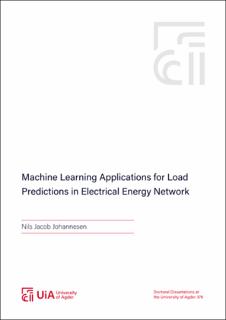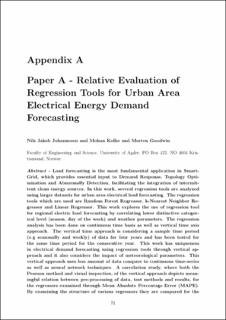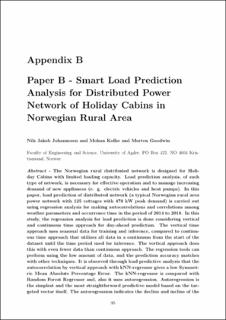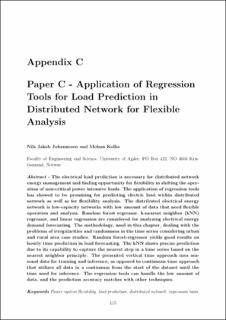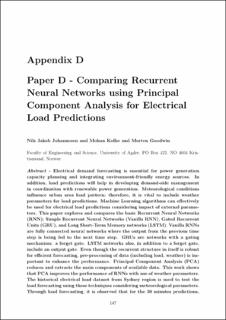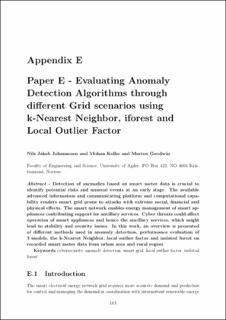| dc.contributor.advisor | Kolhe, Mohan Lal | |
| dc.contributor.advisor | Goodwin, Morten | |
| dc.contributor.author | Johannesen, Nils Jacob | |
| dc.date.accessioned | 2022-09-15T11:26:46Z | |
| dc.date.available | 2022-09-15T11:26:46Z | |
| dc.date.created | 2022-08-25T07:57:16Z | |
| dc.date.issued | 2022 | |
| dc.identifier.citation | Johannesen, N. J. (2022). Machine Learning Applications for Load Predictions in Electrical Energy Network [PhD. thesis]. University of Agder. | en_US |
| dc.identifier.isbn | 978-82-8427-086-9 | |
| dc.identifier.issn | 1504-9272 | |
| dc.identifier.uri | https://hdl.handle.net/11250/3018037 | |
| dc.description.abstract | In this work collected operational data of typical urban and rural energy network are analysed for predictions of energy consumption, as well as for selected region of Nordpool electricity markets. The regression techniques are systematically investigated for electrical energy prediction and correlating other impacting parameters. The k-Nearest Neighbour (kNN), Random Forest (RF) and Linear Regression (LR) are analysed and evaluated both by using continuous and vertical time approach. It is observed that for 30 minutes predictions the RF Regression has the best results, shown by a mean absolute percentage error (MAPE) in the range of 1-2 %. kNN show best results for the day-ahead forecasting with MAPE of 2.61 %. The presented vertical time approach outperforms the continuous time approach. To enhance pre-processing stage, refined techniques from the domain of statistics and time series are adopted in the modelling. Reducing the dimensionality through principal components analysis improves the predictive performance of Recurrent Neural Networks (RNN). In the case of Gated Recurrent Units (GRU) networks, the results for all the seasons are improved through principal components analysis (PCA). This work also considers abnormal operation due to various instances (e.g. random effect, intrusion, abnormal operation of smart devices, cyber-threats, etc.). In the results of kNN, iforest and Local Outlier Factor (LOF) on urban area data and from rural region data, it is observed that the anomaly detection for the scenarios are different. For the rural region, most of the anomalies are observed in the latter timeline of the data concentrated in the last year of the collected data. For the urban area data, the anomalies are spread out over the entire timeline. The frequency of detected anomalies where considerably higher for the rural area load demand than for the urban area load demand. Observing from considered case scenarios, the incidents of detected anomalies are more data driven, than exceptions in the algorithms. It is observed that from the domain knowledge of smart energy systems the LOF is able to detect observations that could not have detected by visual inspection alone, in contrast to kNN and iforest. Whereas kNN and iforest excludes an upper and lower bound, the LOF is density based and separates out anomalies amidst in the data. The capability that LOF has to identify anomalies amidst the data together with the deep domain knowledge is an advantage, when detecting anomalies in smart meter data. This work has shown that the instance based models can compete with models of higher complexity, yet some methods in preprocessing (such as circular coding) does not function for an instance based learner such as k-Nearest Neighbor, and hence kNN can not option for this kind of complexity even in the feature engineering of the model. It will be interesting for the future work of electrical load forecasting to develop solution that combines a high complexity in the feature engineering and have the explainability of instance based models. | en_US |
| dc.language.iso | eng | en_US |
| dc.publisher | University of Agder | en_US |
| dc.relation.ispartofseries | Doctoral Dissertations at the University of Agder; no. 376 | |
| dc.relation.haspart | Paper I: Johannesen, N. J., Kolhe, M. L. & Goodwin, M. (2019). Relative evaluation of regression tools for urban area electrical energy demand forecasting. Journal of Cleaner Production, 218, 555-564. https://doi.org/10.1016/j.jclepro.2019.01.108. Accepted manuscript. Full-text is available in AURA as a separate file: . | en_US |
| dc.relation.haspart | Paper II: Johannesen, N. J., Kolhe, M. L. & Goodwin, M. (2020). Smart load prediction analysis for distributed power network of Holiday Cabins in Norwegian rural area. Journal of Cleaner Production, 266: 121423. https://doi.org/10.1016/j.jclepro.2020.121423. Accepted manuscript. Full-text is available in AURA as a separate file: . | en_US |
| dc.relation.haspart | Paper III: Johannesen, N. J. & Kolhe, M. L. (2021). Application of Regression Tools for Load Prediction in Distributed Network for Flexible Analysis. In H. H. Alhelou, E. Heydarian-Forushani & P. Siano (Eds.), Flexibility in Electric Power Distribution Networks (p. 67-94). CRC Press. https://doi.org/10.1201/9781003122326/. Accepted manuscript. Full-text is available in AURA as a separate file: . | en_US |
| dc.relation.haspart | Paper IV: Johannesen, N. J., Kolhe, M. L. & Goodwin, M. (2021). Comparing recurrent neural networks using principal component analysis for electrical load predictions. In 2021 6th International Conference on Smart and Sustainable Technologies (SpliTech). IEEE. https://doi.org/10.23919/SpliTech52315.2021.9566357. Accepted manuscript. Full-text is available in AURA as a separate file: . | en_US |
| dc.relation.haspart | Paper V: Johannesen, N. J., Kolhe, M. L. & Goodwin, M. (2022). Evaluating Anomaly Detection Algorithms through different Grid scenarios using k-Nearest Neighbor, iforest and Local Outlier Factor. In 2022 7th International Conference on Smart and Sustainable Technologies (SpliTech). IEEE. https://doi.org/10.23919/SpliTech55088.2022.9854355. Accepted manuscript. Full-text is available in AURA as a separate file: <a href> https://uia.brage.unit.no/uia-xmlui/handle/11250/3061191</a>. | en_US |
| dc.rights | Attribution-NonCommercial-NoDerivatives 4.0 Internasjonal | * |
| dc.rights.uri | http://creativecommons.org/licenses/by-nc-nd/4.0/deed.no | * |
| dc.title | Machine Learning Applications for Load Predictions in Electrical Energy Network | en_US |
| dc.type | Doctoral thesis | en_US |
| dc.description.version | publishedVersion | en_US |
| dc.rights.holder | © 2022 Nils Jakob Johannesen | en_US |
| dc.subject.nsi | VDP::Teknologi: 500::Elektrotekniske fag: 540 | en_US |
| dc.subject.nsi | VDP::Teknologi: 500 | en_US |
| dc.source.pagenumber | 201 | en_US |
| dc.source.issue | 376 | en_US |
| dc.identifier.cristin | 2045807 | |
